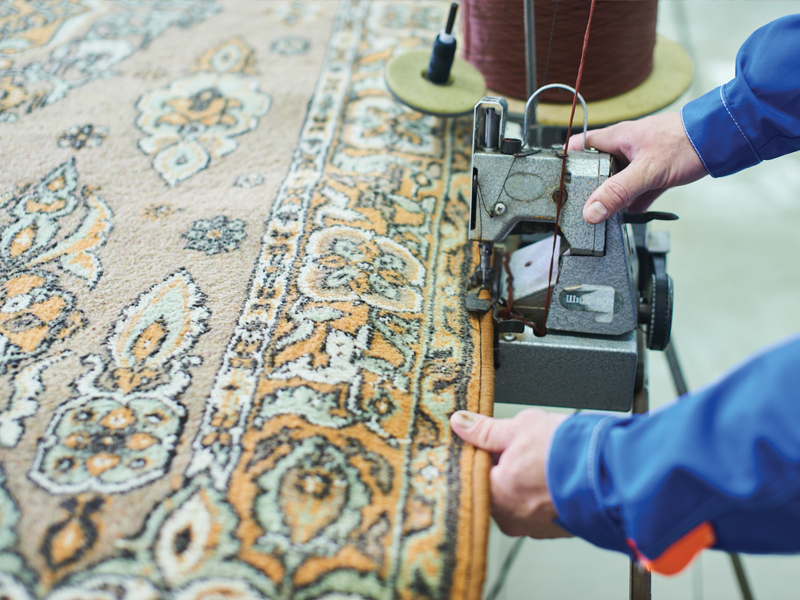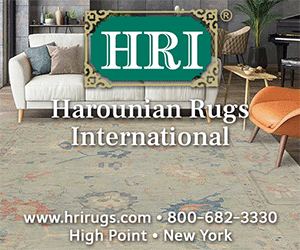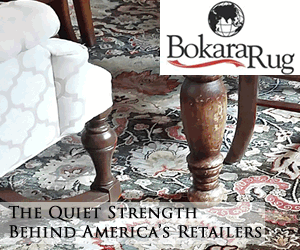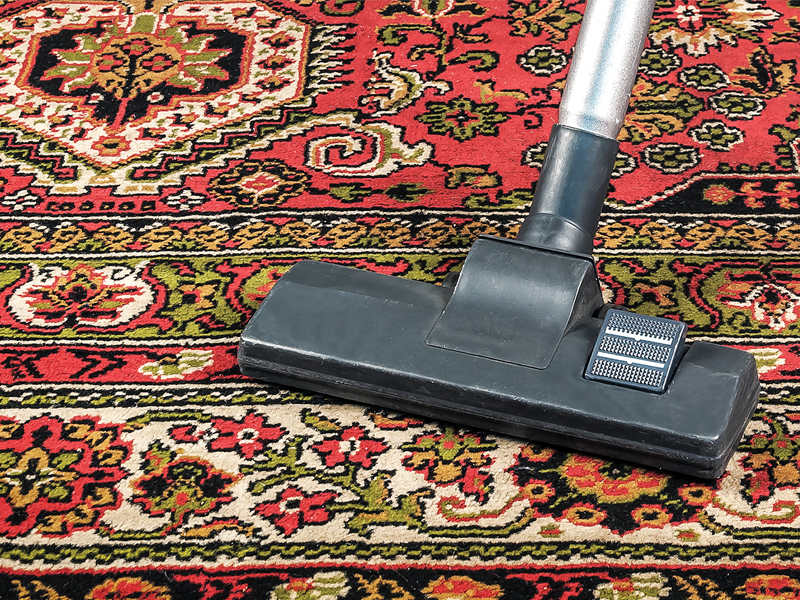In the Summer 2024 issue of RUG INSIDER, we discussed the sustainability in the world of area rugs, and the idea of “Going Green.” For the portion of the rug industry that is focused on modern and contemporary rugs, being green and sustainable generally means being eco-friendly, and transitioning from the usage of synthetic materials, such as viscose and polypropylene, to more natural materials, including wool, cotton, and silk. Similarly, it marks a process of “going green,” and a transition from synthetic dyes to natural dyes, decreasing environmental impact.
Additionally, sustainability signifies the idea of making the rugs in a way to make them to be less of a disposable commodity, and rather a home decor item that can last for longer periods, including making some rugs washable, or at least, less likely to be damaged by water. In many ways, the present is colliding with the past, as these new sustainable and green rugs are increasingly being redesigned to be more like their original counterparts, the ultimate green and sustainable decorative flooring items, antique Persian carpets.
ANTIQUE RUGS: WEAVING AND NATURAL SOURCES
Antique rugs were woven by hand from natural materials, with cotton (or in some cases wool) foundations, and with wool or silk pile. These hand-knotted rugs were the epitome of the cultural artistry of the cities, villages, and tribes in which they were created. The weavers would cull the materials from the natural environment around them, with wool from their sheep and camels, cotton from their lands, and silk and color dyes from the insects, plants, vegetables, and animals in their vicinity. The hand-knotting process would take a group of weavers, often a family, but sometimes a group of professionals, anywhere from one to ten years to complete, depending on the size and complexity of the rugs being woven.
ANTIQUE RUGS: SUSTAINABILITY AND LONGEVITY
These hand-made antique rugs, composed of natural materials, are among the most sustainable, green, environmentally friendly, and long-lasting products you can think of. Being made by hand with natural wool and cotton, these rugs were the ultimate in sustainability, as they had little or no adverse impact on the environment in which they were being woven. The wool being culled from the animals was a natural process, done to benefit and not to adversely impact the sheep or cause harm to the land. The color dyeing process involved the titration of different amounts of organic plant or animal materials in boiling water, without the addition of any harmful chemicals that could cause issues with dangerous runoff or environmental harm. The result of this painstaking hand-weaving process was beautiful carpets that could last not just for a few years, but for decades, and which could be heirloom pieces that could connect generations of a family together.
ANTIQUE RUGS: CARE AND CLEANING
While antique rugs were woven with natural materials and were made in a way that was environmentally healthy and long-lasting, they also require a certain level of care and cleaning to maximize their life span. Here is a brief rundown of care and cleaning methodologies and best practices that are utilized to keep antique rugs in the best shape possible for the long run.
ROTATION
When rugs are laid out on the floor in any given interior space, the pattern of foot traffic on the rug over an extended period might cause wear to the rug’s upward wool pile. To minimize the wear from people walking over the same parts of the rug every day, it is advisable to periodically rotate one’s carpet by 180 degrees, to create even amounts of foot traffic on both sides of the rug, and not just one side.
MOTH PREVENTION
One of the biggest enemies of area rugs are moths, for which the natural wool in the rugs is a highly desirable food source. To prevent rugs from getting infested with moths, it is advisable to keep the rugs open and laid out on one’s floor, as opposed to being rolled up and stored away in a closet, attic or garage. Being open allows airflow and light to reach to the natural materials of the rug, the lack of which increases the chance of moth infestations.
Additionally, one should keep the climate of the environment that the rug is in controlled, so as not to be too hot or too humid. A hot, humid, dark environment with minimal air flow is the one that is most likely for moths to breed in. Mothballs and other such moth prevention products can be used in extreme cases, but one must proceed with caution, as some types of moth balls have been anecdotally known to cause more harm than good.
GENERAL CLEANING
Keeping an area clean and free of dust, dirt, pet hair, and other contaminants will increase a carpet's longevity. Rugs should regularly be given a general cleaning, using a broom or a mechanical vacuum to sweep off dust and dirt, and an electric vacuum in environments that have more pet hair, dander, or other such “dry” contaminants.
Proceed with caution when using an electric vacuum, as they sometimes have abrasive parts or intense levels of suction that can cause damage to a rug with delicate wool or silk pile. When vacuuming a rug, one should make sure to clean not only the surface, but the underside of the rug as well. In addition to vacuuming, another traditional technique is to take the rug into an outdoor environment and position it in a way it can be gently beaten, to release dust, dirt, or other contaminants. When beating a rug, make sure to use something flat, and that is neither sharp nor jagged, to avoid damage. Some people like to beat the rug first, to release all the dirt, and then vacuum the rug afterward.
GENERAL WASHING
In environments where area rugs are not only subject to “dry” contaminants like dust, dirt, and pet hair, but are also subject to “wet” contaminants like drinks, soups, and mud, it is advisable to periodically wash the rug. Unlike some newer modern rugs that can be thrown in a washing machine, vintage and antique area rugs should be washed when laid out on the floor, preferably in an outdoor environment.
The water should be cool or lukewarm, but not too hot, and should have a small amount of gentle laundry detergent or carpet cleaning solution mixed into it to make it sudsy. The sudsy water should be gently brushed along the rug, either with a brush with soft bristles, or with a clean cloth. The sudsy water should be pulled off with a squeegee or wet-dry vacuum and should be followed by a similar cleansing with clear water.
After the cleansing with regular water, the rug should again have the water extracted, either with a squeegee, a wet-dry vacuum, or some other method.
The rug should then be aired out, preferably outdoors in the sun, and allowed to dry fully before being replaced in the indoor environment. The rug should be dried in the sun or with fans, to the point that no water or soapy residue gets trapped in either the foundation or in the pile of the rug, as that could cause damage to the rug, or lead to a mildew smell from the remaining moisture.
STAIN REMOVAL
In instances where a liquid with a strong color or odor spills on the rug, such as wine or pet urine, it should be dabbed up as quickly as possible with a dry white cloth. After extracting as much of the liquid as possible, one can apply some cool water to the stained area and blot out as much color as possible with another dry white cloth. A possible remedy after this point would be to apply a cleaning solution to the stained area and let that sit for 15-20 minutes. The type of cleaning solution varies, depending on the type of liquid that has been spilled, and the severity of the stain. Some such options include club soda, a mixture of dishwashing liquid and hydrogen peroxide, or a mixture of hydrogen peroxide and baking soda. After sitting on the stain for a while, the cleaning solution should be blotted up with a dry white cloth, if it’s a liquid, or vacuumed off with a wet-dry vacuum if it’s a combination of a liquid and a powder like baking soda. Stain removal can be a tricky process, with some types of rugs and some types of stains being easier to remove, and with others being more stubborn and challenging. In the case where the stain is too deep or difficult to remove, it is advisable to seek out professional cleaning.

PROFESSIONAL REPAIR & RESTORATION
While hand-knotted antique rugs with natural materials tend to be much more durable and long-lasting than modern rugs with synthetic materials, it is not uncommon for older rugs to incur wear or damage that would require professional repair or restoration services. This can occur for a variety of reasons, including moth damage, clawing or biting from pets, wear from years of repeat foot traffic, holes or tears from heavy furniture, from sharp chair legs, or from contact with jagged items, and a number of other issues.
When this type of damage occurs, it is best to have a rug expert rectify the problem with professional repair and/or restoration services. Repairs might include the sealing of small holes, the binding of frayed edges, the restoration of lost fringe or wool, or in more extreme cases, the replacement or reweaving of areas of significant loss or deterioration.
RUG PADS
In addition to the care and cleaning methodologies noted here, a simple step that can be taken to protect a rug and prolong its lifespan is to place a custom-sized, non-skid rug pad underneath it. A good rug pad will keep an area rug cushioned and anchored, and prevent it from slipping, sliding, or buckling when people walk over it or move chair legs on it.
There are different types of rug pads, including foam pads, felt pads, rubberized pads, and fiber (i.e. “jute and hair”) pads. These pads come in different levels of thickness, with different types of pads being preferable for different types of area rugs. Foam, felt, and rubberized rug pads are typically used for smaller, thinner, or shorter pile rugs, and fiber pads are typically used for larger, thicker, or higher pile rugs. Regardless, rug pads are an important part of the process of keeping an area rug cushioned, anchored, and stabilized, and a key element of preventative maintenance to prevent damage and duress to rugs that occurs from buckling, slipping, sliding, and other such dynamics.
With the progression of the area rug industry toward making new rugs that are more sustainable, eco-friendly, and green than before, many people are gaining a new level of appreciation for vintage and antique rugs, and recognizing them as not only the original sustainable and green types of flooring, but also as a beautiful form of cultural expression that is tactile, interactive, has incredible longevity, and which can be a part of their homes and families for a long time to come.
For questions or assistance with rug washing, repair and restoration contact us at This email address is being protected from spambots. You need JavaScript enabled to view it. or by phone at (212) 683-2699.





